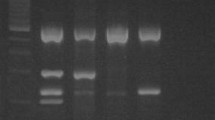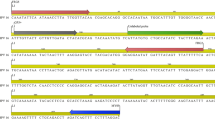Abstract
Background
Human papillomaviruses (HPV) are known to play a central etiological role in the development of cervical cancer. General HPV genotyping methods consist of PCR with consensus primers combined with various detection methods.
Objective
The aim was to develop HPV L1 DNA reference materials to evaluate the sensitivity, specificity, and accuracy of genotyping results obtained from the HPV DNA Genotyping Chip (HPV CHIP) and RFMP assays.
Methods
In this study, the Ministry of Food and Drug Safety (MFDS) established reference DNA materials for the L1 gene from 41 subtypes of anogenital HPV to aid in genotyping human papillomavirus (HPV) strains. Of these, 22 subtypes were obtained from cervical scrape samples of Korean women and 19 subtypes were synthesized. These reference materials include 13 high-risk types (HPV-16, 18, 31, 33, 35, 39, 45, 51, 52, 56, 58, 59, and 68), 3 probable high-risk types (HPV-26, 53, and 66), 16 low-risk types (HPV-6, 10, 11, 27, 34, 40, 42, 43, 44, 54, 55, 61, 70, 72, 73, and 81), and 8 undetermined-risk types (HPV-3, 57, 62, 67, 69, 71, 74, and 84). After confirming the sequences by standard methods, these HPV L1 DNA reference materials were then used to compare results from the HPV DNA Genotyping Chip (HPV CHIP) and restriction fragment mass polymorphism (RFMP) assays.
Results
Data collected from the HPV CHIP and RFMP assay showed comparably high sensitivity and accuracy. Both assays could detect 102 or more copies/μl of HPV L1 DNA from 39 types of HPV, with higher accuracy in detecting samples with mixed types of HPV.
Conclusion
The present study confirms the HPV L1 DNA reference materials developed by MFDS are reliable and useful for the evaluation of HPV genotyping assays.


Similar content being viewed by others
References
Abdi F, Bradbury EM, Doggett N, Chen X (2001) Rapid characterization of DNA oligomers and genotyping of single nucleotide polymorphism using nucleotide-specific mass tags. Nucleic Acids Res 29:E61-61
Ahn SH, Chun JY, Shin SK, Park JY, Yoo W, Hong SP, Kim SO, Han KH (2013) Performance evaluation of the HepB Typer-Entecavir kit for detection of entecavir resistance mutations in chronic hepatitis B. Clin Mol Hepatol 19:399–408
Chan SY, Delius H, Halpern AL, Bernard HU (1995) Analysis of genomic sequences of 95 papillomavirus types: uniting typing, phylogeny, and taxonomy. J Virol 69:3074–3083
Digene Corporation (2005) Hybrid capture 2 high-risk HPV DNA test vol 5199–1220. Digene Corporation
Evander M, Boden E, Bjersing L, Rylander E, Wadell G (1991) Oligonucleotide primers for DNA amplification of the early regions 1, 6, and 7 from human papillomavirus types 6, 11, 16, 18, 31, and 33. Arch Virol 116:221–233
Gravitt PE, Peyton CL, Apple RJ, Wheeler CM (1998) Genotyping of 27 human papillomavirus types by using L1 consensus PCR products by a single-hybridization, reverse line blot detection method. J Clin Microbiol 36:3020–3027
Greiner Bio-One (2008) Papillocheck—test kit for the genotyping of 24 types of genital HPV vol BQ-013-04. Greiner Bio-One
Haff LA, Smirnov IP (1997) Single-nucleotide polymorphism identification assays using a thermostable DNA polymerase and delayed extraction MALDI-TOF mass spectrometry. Genome Res 7:378–388
Hong SP, Kim NK, Hwang SG, Chung HJ, Kim S, Han JH, Kim HT, Rim KS, Kang MS, Yoo W et al (2004) Detection of hepatitis B virus YMDD variants using mass spectrometric analysis of oligonucleotide fragments. J Hepatol 40:837–844
Hong SP, Shin SK, Lee EH, Kim EO, Ji SI, Chung HJ, Park SN, Yoo W, Folk WR, Kim SO (2008) High-resolution human papillomavirus genotyping by MALDI-TOF mass spectrometry. Nat Protoc 3:1476–1484
Hwang T (1999) Detection and typing of human papillomavirus DNA by PCR using consensus primers in various cervical lesions of Korean women. J Korean Med Sci 14:593–599
Kim HS, Han KH, Ahn SH, Kim EO, Chang HY, Moon MS, Chung HJ, Yoo W, Kim SO, Hong SP (2005) Evaluation of methods for monitoring drug resistance in chronic hepatitis B patients during lamivudine therapy based on mass spectrometry and reverse hybridization. Antivir Ther 10:441–449
Kim KH, Yoon MS, Na YJ, Park CS, Oh MR, Moon WC (2006) Development and evaluation of a highly sensitive human papillomavirus genotyping DNA chip. Gynecol Oncol 100:38–43
Kleter B, van Doorn LJ, Schrauwen L, Molijn A, Sastrowijoto S, ter Schegget J, Lindeman J, ter Harmsel B, Burger M, Quint W (1999) Development and clinical evaluation of a highly sensitive PCR-reverse hybridization line probe assay for detection and identification of anogenital human papillomavirus. J Clin Microbiol 37:2508–2517
Kombe AJK, Li B, Zahid A, Mengist HM, Bounda GA, Zhou Y, Jin T (2020) Epidemiology and burden of human papillomavirus and related diseases molecular pathogenesis, and vaccine evaluation. Front Public Health 8:552028
Laken SJ, Jackson PE, Kinzler KW, Vogelstein B, Strickland PT, Groopman JD, Friesen MD (1998) Genotyping by mass spectrometric analysis of short DNA fragments. Nat Biotechnol 16:1352–1356
Lauman R, Garcia BA (2020) Unraveling the RNA modification code with mass spectrometry. Mol Omics 16:305–315
Mauger F, Jaunay O, Chamblain V, Reichert F, Bauer K, Gut IG, Gelfand DH (2006) SNP genotyping using alkali cleavage of RNA/DNA chimeras and MALDI time-of-flight mass spectrometry. Nucleic Acids Res 34:e18
Munoz N, Bosch FX, de Sanjose S, Herrero R, Castellsague X, Shah KV, Snijders PJ, Meijer CJ (2003) Epidemiologic classification of human papillomavirus types associated with cervical cancer. N Engl J Med 348:518–527
Oh TJ, Kim CJ, Woo SK, Kim TS, Jeong DJ, Kim MS, Lee S, Cho HS, An S (2004) Development and clinical evaluation of a highly sensitive DNA microarray for detection and genotyping of human papillomaviruses. J Clin Microbiol 42:3272–3280
Ross P, Hall L, Smirnov I, Haff L (1998) High level multiplex genotyping by MALDI-TOF mass spectrometry. Nat Biotechnol 16:1347–1351
Sauer S, Reinhardt R, Lehrach H, Gut IG (2006) Single-nucleotide polymorphisms: analysis by mass spectrometry. Nat Protoc 1:1761–1771
Sun Z, Zhang R, Liu Z, Liu C, Li X, Zhou W, Yang L, Ruan Q, Zhang X (2015) Development of a fluorescence-based multiplex genotyping method for simultaneous determination of human papillomavirus infections and viral loads. BMC Cancer 15:860
Vernon SD, Unger ER, Williams D (2000) Comparison of human papillomavirus detection and typing by cycle sequencing, line blotting, and hybrid capture. J Clin Microbiol 38:651–655
WHO (2009) WHO HPV Laboratory Network. Newsletter No.4. https://www.who.int/biologicals/vaccines/hpv/HPV_LabNet_Newsletter_No_4.pdf?ua=1. Accessed 12 June 2009
Wolfe JL, Kawate T, Sarracino DA, Zillmann M, Olson J, Stanton VP Jr, Verdine GL (2002) A genotyping strategy based on incorporation and cleavage of chemically modified nucleotides. Proc Natl Acad Sci USA 99:11073–11078
Yusupov A, Popovsky D, Mahmood L, Kim AS, Akman AE, Yuan H (2019) The nonavalent vaccine: a review of high-risk HPVs and a plea to the CDC Am J. Stem Cells 8:52–64
zur Hausen H (1996) Papillomavirus infections—a major cause of human cancers. Biochim Biophys Acta 1288:F55-78
zur Hausen H, Gissmann L, Schlehofer JR (1984) Viruses in the etiology of human genital cancer. Prog Med Virol 30:170–186
Acknowledgements
The author thanks Britni M. Arlian (Scripps Research Institute), TaeJeong Oh (GenomicTree) for scientific discussions.
Funding
This research was supported by the National Research Foundation of Korea (NRF) grant (NRF-2019R1I1A1A01043181) and Korea Innovation Foundation grant (2020-DD-RD-0735) funded by the Korea government.
Author information
Authors and Affiliations
Corresponding author
Ethics declarations
Conflict of interest
Author Kyung Ho Han declares that he has no conflict of interest.
Ethical approval
Informed consent and pertinent patient information for each sample was obtained under approval and guidance of the Institutional Review Board of the School of Medicine at ChungNam National University.
Informed consent
Informed consent was obtained from all individual participants included in the study.
Additional information
Publisher's Note
Springer Nature remains neutral with regard to jurisdictional claims in published maps and institutional affiliations.
Supplementary Information
Below is the link to the electronic supplementary material.
Rights and permissions
About this article
Cite this article
Han, K.H. Evaluation of human papillomavirus (HPV) genotyping assays using type-specific HPV L1 reference DNA. Genes Genom 43, 775–781 (2021). https://doi.org/10.1007/s13258-021-01100-4
Received:
Accepted:
Published:
Issue Date:
DOI: https://doi.org/10.1007/s13258-021-01100-4




